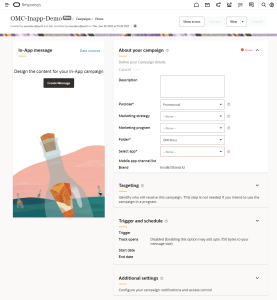Launching an In-app campaign with the Campaign Designer
Important: This information applies to the In-app Campaign Designer, which is now generally available for all accounts. It replaces the In-app Campaign Workbook.
To see how the In-app Campaign Designer differs from the old Campaign Workbook, see In-app Campaign Designer changes. For a breakdown of the Campaign Designer's visuals, see In-app Campaign Designer visuals overview.
The Campaign Designer has a simplified workflow and easy to follow interface. Use the Campaign Designer as part of your customer engagement strategy by reaching customers through communication personalized to them. In-app campaigns let
you show alerts or full screen landing pages from within your app when a specified action occurs. In-app messages can be shown either when the app is opened, or when a custom trigger event such as add to cart occurs. In-app campaigns can be sent to opted-out users, whereas Push campaigns exclude opted-out users.
Note: The custom trigger events must be configured by your app developer and you must obtain the name of the custom trigger event.
You can include audio and video content and dynamic content in in-app messages. An in-app campaign can be associated with only one app and uses the same profile table as the app.
With the Campaign Designer, create and launch a campaign in four steps:
- Create your campaign and define its targeting
- Create personalized messaging
- Test your campaign
- Launch your campaign
To navigate to the Campaign Designer :
- On the side navigation bar, click
 Campaigns and select Manage Campaigns.
Campaigns and select Manage Campaigns.The Manage campaigns page opens.
- Click Create Campaign, or open an existing campaign.
Step 1: Create a targeted campaign
- Create your in-app campaign
- Select your app and configure the About your campaign panel
- Configure the Targeting panel to ensure your campaign is targeted
- Configure the Trigger and schedule panel
- Configure the Additional settingspanel
